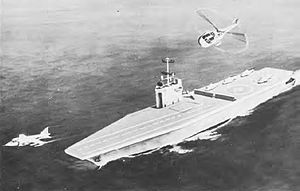
The Sea Control Ship (SCS) was a small aircraft carrier developed and conceptualized by the United States Navy under Chief of Naval Operations Elmo Zumwalt during the 1970s. Currently the term refers to naval vessels that can perform similar duties. The SCS was intended as an escort vessel, providing air support for convoys. It was canceled after budgetary cuts to the US Navy.
The SCS was to be equipped with a mix of Rockwell XFV-12 fighter aircraft and anti-submarine warfare helicopters. It was tasked with carrying out anti-submarine warfare operations.
In the late 1960s, studies by US Navy identified a potential requirement for large scale convoy operations in the event of a war with the Soviet Union. In order to compensate for a shortage of escort ships, it was suggested that helicopters operating from small helicopter carriers could fill the gap. When Elmo Zumwalt became Chief of Naval Operations in 1970, he seized on the idea of small helicopter carriers as part of his "High-Low" plan in which large numbers of cheaper lower capability ships would be built to supplement existing expensive high capability ships. The proposed small carrier, which was named the Sea Control Ship (SCS), was required to provide continuous airborne cover of two anti-submarine and one airborne early warning helicopters, as well as carrying VSTOL fighters to stop Soviet long-range aircraft (like the Tupolev Tu-95 "Bear") from shadowing convoys and directing submarines and surface ships against them. This resulted in a requirement to carry 14 helicopters and three VSTOL fighters such as the AV-8 Harrier. It was hoped that production SCSs could be built for $100Â million each, an eighth of the price of a full sized CVN.